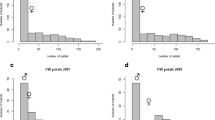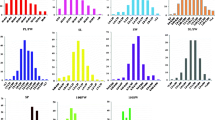Abstract
A segregating progeny set of 96 F1 diploid hybrids (2n=2x=14) between “Blush Noisette” (D10), one of the first seedlings from the original “Champneys’ Pink Cluster”, and Rosa wichurana (E15), was used to construct a genetic linkage map of the rose genome following a “pseudo-testcross” mapping strategy. A total of 133 markers (130 RAPD, one morphological and two microsatellites) were located on the 14 linkage groups (LGs) of the D10 and E15 maps, covering total map lengths of 388 and 260 cM, respectively. Due to the presence of common biparental markers the homology of four LGs between parental maps (D10-1/E15-1 to D10-4/E15-4) could be inferred. Four horticulturally interesting quantitative traits, flower size (FS), days to flowering (DF), leaf size (LS), and resistance to powdery mildew (PM) were analysed in the progeny in order to map quantitative trait loci (QTLs) controlling these traits. A total of 13 putative QTLs (LOD>3.0) were identified, four for FS, two for flowering time, five for LS, and two for resistance to PM. Possible homologies between QTLs detected in the D10 and E15 maps could be established between Fs1 and Fs3, Fs2 and Fs4, and Ls1 and Ls3. Screening for pairwise epistatic interactions between loci revealed additional, epistatic QTLs (EQTLs) for DF and LS that were not detected in the original QTL analysis. The genetic maps developed in this study will be useful to add new markers and locate genes for important traits in the genus providing a practical resource for marker-assisted selection programs in roses.


Similar content being viewed by others
References
Aranzana MJ, Pineda A, Cosson E, Dirlewanger E, Ascasibar J, Cipriani G, Ryder CD, Testolin R, Abbott A, King GJ, Iezzoni A, Arús P (2003) A set of simple-sequence repeat (SSR) markers covering the Prunus genome. Theor Appl Genet 106:819–825
Atienza SG, Satovic Z, Petersen KK, Dolstra O, Martín A (2002) Preliminary genetic linkage map of Miscanthus sinensis with RAPD markers. Theor Appl Genet 105:946–952
Cardy BJ, Stuber CW, Goodman MM (1980) Techniques for starch-gel electrophoresis of enzymes from maize (Zea mays L.). Mimeo Series, North Carolina State University Department of Statistics, Raleigh
Chase K, Adler FR, Lark KG (1997) Epistat: A computer program for identifying and testing interactions between pairs of quantitative trait loci. Theor Appl Genet 94:724–730
Cheng FS, Brown SK, Weeden NF (1997) A DNA extraction protocol from various tissues in woody species. Hortscience 32:921–922
Churchill GA, Doerge RW (1994) Empirical threshold values for quantitative trait mapping. Genetics 138:963–971
Clayton JW, Tretiak DN (1972) Amino-citrate buffers for pH control in starch-gel electrophoresis. J Fish Res Bd Can 29:1169–1172
Crespel L, Chirollet M, Durel CE, Zhang D, Meynet J, Gudin S (2002) Mapping of qualitative and quantitative phenotypic traits in Rosa using AFLP markers. Theor Appl Genet 105:1207–1214
Debener T (1999) Genetic analysis of horticulturally important morphological and physiological characters in diploid roses. Gartenbauwissenschaft 64:14–20
Debener T, Mattiesch L (1999) Construction of a genetic linkage map for roses using RAPD and AFLP markers. Theor Appl Genet 99:891–899
Debener T, Bartels C, Mattiesch L (1996) RAPD analysis of genetic variation between a group of rose cultivars and selected wild rose species. Mol Breed 2:321–327
Debener T, Janakiram T, Mattiesch L (2000) Sports and seedlings of rose varieties analysed with molecular markers. Plant Breed 119:71–74
Debener T, von Malek B, Mattiesch L, Kaufmann H (2001) Genetic and molecular analysis of important characters in roses. Acta Hort 547:45–49
De Vries DP, Dubois LAM (1978) On the transmission of the yellow flower colour from Rosa foetida to recurrent flowering hybrid tea-roses. Euphytica 27:205–210
De Vries DP, Dubois LAM (1984) Inheritance of the recurrent flowering and Moss characters in F1 and F2 hybrid Tea × R. centifolia muscosa (Aiton) Seringe populations. Gartenbauwissenschaft 49:97–100
Esselink GD, Smulders MJM, Vosman B (2003) Identification of cut rose (Rosa hybrida) and rootstock varieties using sequence tagged microsatellite site markers. Theor Appl Genet 106:227–286
Gottlieb LD (1973) Enzyme differentiation and phylogeny in Clarkia franciscana, C. rubicundaand C. amoena. Evolution 27:205–214
Grattapaglia D, Sederoff R (1994) Genetic linkage maps of Eucalyptus grandis and Eucalyptus urophylla using a pseudo-testcross mapping strategy and RAPD markers. Genetics 137:1121–1137
Gudin S (2000) Rose: genetics and breeding. Plant Breed Rev 17:159–189
Guilford P, Prakash S, Zhu JM, Gardiner S, Basset H, Forster R (1997) Microsatellites in Malus × domestica (apple): abundance polymorphisms and cultivar identification. Theor Appl Genet 94:249–254
Jansen RC, Stam P (1994) High resolution of quantitative traits into multiple loci via interval mapping. Genetics 136:1447–1455
Joobeur T, Viruel MA, De Vicente MC, Jauregui B, Ballester J, Dettori MT, Verde I, Truco MJ, Messeguer R, Batlle I, Quarta R, Dirlewanger E, Arús P (1998) Construction of a saturated linkage map for Prunus using an almond × peach F2 progeny. Theor Appl Genet 97:1034–1041
Kianian SF, Quiros CF (1992) Generation of a Brassica oleracea composite RFLP map: Linkage arrangements among various populations and evolutionary implications. Theor Appl Genet 84:544–554
Knott SA, Neale DB, Sewell MH, Haley CS (1997) Multiple marker mapping of quantitative trait loci in an outbred pedigree of loblolly pine. Theor Appl Genet 94:810–820
Lander ES, Botstein D (1989) Mapping Mendelian factors underlying quantitative traits using RFLP linkage maps. Genetics 121:185–199
Lark KG, Chase K, Adler F, Mansur LM, Orf JH (1995) Interactions between quantitative trait loci in soybean in which trait variation at one locus is conditional upon a specific allele at another. Proc Natl Acad Sci USA 92:4656–4660
Lewis WH, Basye RE (1961) Analysis of nine crosses between diploid Rosa species. Proc Am Soc Hort Sci 78:572–579
Linde M, Debener T (2003) Isolation and identification of eight races of powdery mildew of roses (Podosphaera pannosa) (Wallr:Fr) de Bary and the genetic analysis of the resistance gene Rpp1. Theor Appl Genet 107:256–262
Malek VB, Debener T (2000) Identification of molecular markers linked to Rdr1, a gene conferring resistance to blackspot in roses. Theor Appl Genet 101:977–983
Michelmore RW, Paran I, Kesseli RV (1991) Identification of markers linked to disease-resistance genes by bulked segregant analysis: A rapid method to detect markers in specific genomic regions by using segregating populations. Proc Natl Acad Sci USA 88:9828–9832
Pozárková D, Koblízková A, Román B, Torres AM, Lucretti S, Lysák M, Dolezel J, Macas J (2002) Development and characterization of microsatellite markers from chromosome l-specific DNA libraries of Vicia faba. Biologia Plantarum 45:337–345
Rajapakse S, Byrne DH, Zhang L, Anderson N, Arumuganathan K, Ballard RE (2001) Two genetic linkage maps of tetraploid roses. Theor Appl Genet 103:575–583
Selander RK, Smith MH, Yang SY, Johnson WE, Gentry JB (1971) Biochemical polymorphism and systematics in the genus Peromyscus. I. Variation in the old-field mouse (Peromyscus polionotus). Univ Texas Publ 7103:49–90
Sosinski B, Gannavarapu M, Hager LD, Beck LE, King GJ, Ryder CD, Rajapakse S, Baird WV, Ballard RE, Abbott AG (2000) Characterization of microsatellite markers in peach [ Prunus persica (L.) Batsch]. Theor Appl Genet 101:421–428
Stam P (1993) Construction of integrated genetic linkage maps by means of a new computer package: JoinMap. Plant J 3:739–744
Torres AM, Weeden NF, Martín A (1993) Linkage among isozyme, RFLP and RADP markers in Vicia faba. Theor Appl Genet 85:937–945
Van Ooijen JW (1992) Accuracy of mapping quantitative trait loci in autogamous species. Theor Appl Genet 84:803–811
Van Ooijen JW, Maliepaard C (1996) MapQTL, Version 3.0: software for the calculation of QTL positions on genetic maps. CPRO-DLO, Wageningen The Netherlands
Van Ooijen JW, Voorrips VE (2001) JoinMap 3.0, Software for the calculation of genetic linkage maps. Plant Research International, Wageningen, The Netherlands
Voorrips RE (2002) MapChart: Software for the graphical presentation of linkage maps and QTLs. J Hered 93:77–78
Weeden NF, Emmo AC (1985) Isozyme characterization of Kentucky bluegrass cultivars. Can J Plant Sci 65:985–994
Wendel JF, Weeden NF (1990) Visualization and interpretation of plant isozymes. In: Isozymes in plant biology Dioscorides Press, Portland, Oregon, pp 5–45
Yin T, Huang M, Wang M, Zhu L-H, Zeng Z-B, Wu R (2001) Preliminary interespecific genetic maps of the Populus genomes constructed from RAPD markers. Genome 44:602–609
Acknowledgements
This study was supported by the Spanish Instituto Nacional de Investigaciones Agrarias, Project No. RTA01-126. We would like to thank J. Prieto and C. Martínez for technical support and Dr. A. Di Pietro for critical reading of the manuscript.
Author information
Authors and Affiliations
Corresponding author
Additional information
Communicated by H. Nybom
Rights and permissions
About this article
Cite this article
Dugo, M.L., Satovic, Z., Millán, T. et al. Genetic mapping of QTLs controlling horticultural traits in diploid roses. Theor Appl Genet 111, 511–520 (2005). https://doi.org/10.1007/s00122-005-2042-4
Received:
Accepted:
Published:
Issue Date:
DOI: https://doi.org/10.1007/s00122-005-2042-4




